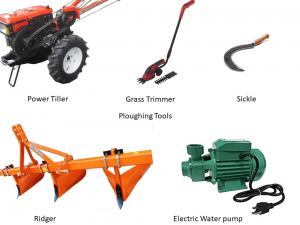Furrow Irrigation
Furrow irrigation is surface irrigation in which furrows or trenches are dug between crop rows in a field and it is suitable for a wide range of soil types, crops, and land slopes.
In furrow irrigation method for suitable plants to grow, water channels are laid in such a way where gravity plays the role of providing just enough water to plants.
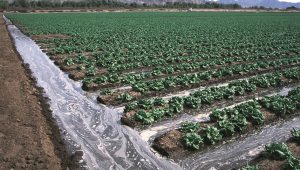
By the planned placement of ridges and furrows this type of irrigation is made and based on the type of soil, a ridge is the part of the layout of the field that is elevated at different angles.
To the growing of tree crops, furrow irrigation is also suited and one furrow alongside the tree row may be sufficient in the early stages of tree planting but two or more furrows can be constructed to provide sufficient water as trees develop.
Use of Furrow Irrigation:
For two reasons furrow irrigation is a more preferred way of irrigation;
- For irrigation, it reduces the cost.
- More guaranteed higher yield by furrow irrigation.
Furrow Planning:
While implementing the furrow irrigation design, a lot of factors need to be kept in mind.
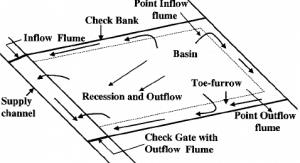
While furrow planning design you have to keep important points in mind as given below;
Shape:
While creating the shape and size of the furrows, there are two prime factors that you need to consider such as;
- Soil Type; The furrows should be rather deep and narrow if the soil is sandy because sandy soil has less impenetrability and the furrows should be shallow and wide if the soil is like clay.
- Water Stream-Flow; The furrows should be bigger and deeper in size for increased holding capacity of water if the water flow is more.
Length:
There are following factors of length such as;
Slope;
0.5 to 0.05% slope of a maximum and minimum range of the soil will determine the length of the slope. When the land slope is steeper furrows can be longer and when the mainland slope does not exceed 3% furrows can be set in this way.
Soil Type;
Water infiltrates rapidly in sandy soils and furrows should be short and then without excessive percolation losses water will reach the downstream end.
The infiltration rate is much lower in clay soils and furrows can be much longer on clayey soils.
The shorter will be the furrow if the field is sander and to clay-like soil, a vice-versa situation applies.
Stream Size;
Keep the water flow not more than 3 liters/sec and not less than 0.5 liters/sec to avoid soil erosion.
Water will move rapidly down the furrows with larger stream sizes and on the furrow slope, the maximum stream size that will not cause erosion will depend.
Irrigation Depth;
If the furrow is deeper it can contain more water hence it can be longer.
Field-Length;
To make the furrow length equal to the length of the field, it may be more practical, and to fit the field boundaries, furrow lengths are made.
To the length of the field, the ideal size can be overlooked and can be adjusted.
Space:
You can keep two factors in mind while planning for space such as;
- Bed Soil
- Cultivation Procedure
Bed Soil;
It depends on the soil type and wit the lesser penetrable the soil is the lesser spacing for coarse to fine sand to clay soil and this is due to differences in depth of furrows in the length section.
Cultivation Procedure;
In between the furrowing tool and the space required for the plants from one row to another you will see a dissimilarity and to ensure proper reach of soil to the roots, both characteristics need to be brought in half ways.
Equipment of Furrow Irrigation:
There are the following equipment which is used in the furrow irrigation such as;
- Plowing Tools such as Power Tiller, or Grass Trimmer.
- Ridge.
- Electric Water pump.
- Gate.
Application Steps of Furrow Irrigation:
There are the following three steps in the application of furrow irrigation as given below:
- Drawing the Furrows.
- Ridging.
- Equal Distancing.
Drawing the Furrows:
Before taking out a ridger and creating furrows, the furrows can be marked out with chalk and to achieve more accuracy poles also can be used.
Ridging:
As long as the chalked-out areas are not drawn in straight lines the furrows need to create with a ridger.
Equal Distancing:
At least 5 meters distance should be taken between two ridges and you could use a four-ridging drawbar for easier maintenance.
Types of Furrow Irrigation:
There are four types of furrow irrigation;
- Level Furrows
- Graded Straight Furrows
- Graded Contour Furrows
- Corrugations
Level Furrows:
These are small irrigation channels with blocked ends laid out with no grade or little grade and until the furrow capacity is filled, Water is applied using a large stream.
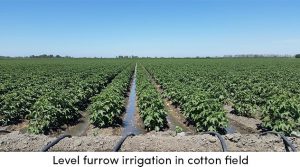
For crops grown in rows on beds between the furrows, as well as for all climatic areas, level furrows are best suited and for successful operation, this type requires very extensive land preparation and careful water management.
Graded Straight Furrows:
In this type to irrigate all row crops, small irrigation channels in a straight line are made and parallel to a field boundary and this type of irrigation is used on all soils except sandy soils.
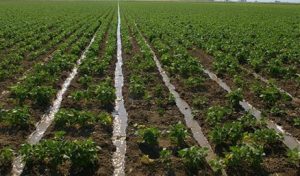
A well-leveled field with little or no slope and high human labor is required in this type.
Graded Contour Furrows:
With uneven or warped surfaces, small graded irrigation channels are provided in this type, and on surfaces where it is not practical to use straight furrows, this type is mainly used.
To fit the field contour, the furrows are curved and this type can be used on all slopes and soil types except the soils which are dry and can crack easily.
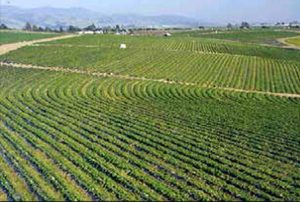
Constant furrow management and rodent control to prevent furrow damage
Corrugations:
Corrugations are used to irrigate close-growing crops on moderately steep land and are small, closely spaced irrigation channels.
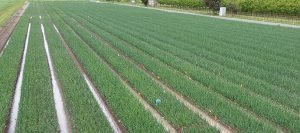
Through small channels or corrugations evenly spaced across the field, irrigation water is applied and channels need to conform to the field slope due to their small capacity.
Maintenance of Furrow Irrigation:
- Checking proper water flow downstream.
- Ridges should not erode to the furrow level.
- Keeping weed under control.
- No dry spots in furrows.
Advantages:
- This method of irrigation is cost-efficient.
- This method can save time and labor.
- There is optimum water distribution in furrow irrigation.
- Mass area irrigation.
Disadvantages:
- There is more initial labor cost.
- For some crops, it is not suitable.
The post Furrow Irrigation | Furrow Planning, Application Steps & 4 Types appeared first on Civil Click.
from Posts – Civil Click https://ift.tt/35MG5fr


